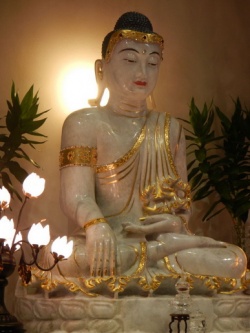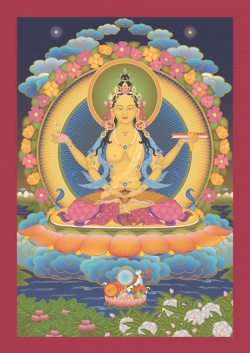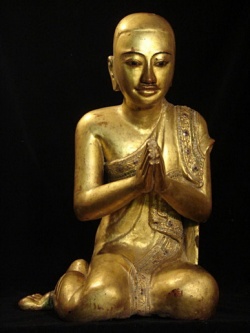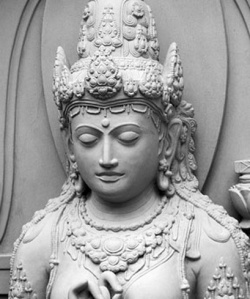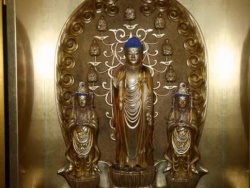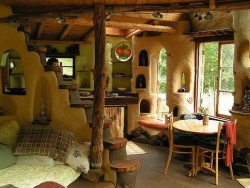Arhat (Rakan)
ARAKAN 阿羅漢, RAKAN 羅漢 (Japanese)
ARHAT, ARHAN, ARAHAT, ARIHAT, ARIHAN (Sanskrit)
ari = enemy | han = kill or slay
Also; Ōgu (J) 應供, "Worthy of Obeisance and Respect"
Ōgu is also one of the Ten Epithets 十號 (Jūgō) of the Buddha
Also; Setsuzoku (J) 殺賊, "Foe Destroyer," or "Enemy Slayer"
Also; Mugaku (J) 無学, "Nothing Else to Learn"
THE EARLY YEARS
The early Buddhists split into a number of factions following the death of the Historical Buddha (he died around 483 BC), each faction holding firm to its own interpretations. Roughly 500 years later, two main schools emerged -- the Theravada and Mahayana schools. Theravada sought to preserve the original and orthodox teachings of Gautama Buddha (the Historical Buddha). The Mahayana tradition was more flexible and innovative. At the time, the distinction between Theravada and Mahayana was politicized into arguments over "benefitting self" and "benefitting others." Mahayana adherents insisted that only by benefitting others could one hope to benefit oneself. To Mahayana followers, the Theravada philosophy is false, for Theravada stresses "self benefit" -- practicing the monastic life for oneself, by oneself, strictly for one's own emancipation. Indeed, the term "Hinayana," meaning Lesser Vehicle, was attached to the Theravada school by Mahayana adherents, who hoped to portray the Theravada teachings as inferior. Thus, the term Hinayana is derogatory and used to denigrate Theravada traditions. It is a term that should be (and is) avoided by most modern scholars. Main Schools for more on this early schism.
Legend contends that the Lord Buddha (or Sakyamuni in Sanskrit; he is no longer called Siddhartha after reaching Buddhahood) decided to keep his achievement and teachings to himself, for others would not believe or comprehend. But his mind was changed by the appearance before him of Brahman (the chief Hindu god of that age; Jp. = Bonten), who urged him to preach what he had learned and help others along the same path. From that point on, until his death at age 80, the Buddha preached without interval. The Chinese transliterated Sakyamuni as Shakamuni, but this was later shortened to Shaka in both China and Japan. "Shaka" is another word for the Historical Buddha, for as a human, he was born into the Sakya (Shaka) clan, a tribe that ruled a small state that today is located in Tarai (Nepal) near the border with India.
His companion ascetics were the first to become his disciples, and soon afterwards they too attained enlightenment -- in Sanskrit they are known as the Arhan (Jp. = Arakan 阿羅漢), an Indian word meaning "one who is worthy of receiving obeisance" or "slayer of enemies." Arhatship is the main goal of all who practice Theravada Buddhism.
The most famous of the early disciples are called the Ten Great Disciples (Jūdai Deshi 十大弟子), and they played a major role in Buddhism's early development and transmission within India.
FOUR ARHATS. In the earliest Indian sutras, however, the Historical Buddha is said to have asked only four arhats to remain in the world to propagate Buddhist law (dharma). Each of the four was associated with one of the four compass directions.
1. Bindora Baradaja (J) 賓度羅跋羅惰闍. Also called Binzuru (J). Pindola Bharadraja (Skt). Associated with compass direction = West; resides with 1,000 disciples in Saikudani-shi (Skt. Aparagodani); the most widely revered of the Arhats in Japan; all the others are less known to Japanese lay worshippers, and they rarely serve as the central objects of devotion. Pindola, however, according to the Flammarion Iconographic Guide on Buddhism, is the Arhat par excellence in Japan, and is mainly worshipped by lay people. Quote: "In Japan, Pindola is represented as an old man seated on a high-backed chair, with white hair and bushy eyebrows. Statues of him, in painted wood or stone, are usually well worn, since the faithful follow the custom of rubbing a part of the effigy corresponding to the sick parts of their bodies, as he is reputed to have the gift of healing. (Schumacher here. Statues that are rubbed in Japan are called nadebotoke 撫で仏 , literally "rubbing Buddha statues;" natabotoke are not limited to Binzura, but include other deities like Jizō, Kannon, Daikokuten, and Fudō.] He is also very frequently offered red and white bibs and children's caps to watch over the health of babies, so that his statue is often decked in rags. He is represented in painting as an old man seated on a rock, holding in his hand a sort of sceptre (Japanese shaku), or a sutra box and a feather fan. All the other Arahants are usually worshipped in Japan in his person. In some cases, his efficgy is placed in monastery refectories, as at the Jikido (Shakudo) in Todai-ji Temple (Nara), and in Hieizan." <end quote> In Japan, a special Binzuru ceremony known as Binzuru Mawashi 賓頭盧廻 is held on the sixth of January at Zenkō-ji 善光寺 in Nagano.
2. Kanakabassa (J) 迦諾迦伐蹉; Kanakavatsa (Skt.)
North; resides with 500 disciples in Kashmir (Hokukuru-shu; J)
3. Hantaka (J) 半託迦; Panthaka (Skt.)
East; resides with 1,300 disciples in the Heaven of 33 Gods, or Toshoshin-shu (J).
4. Nakora (J) 諾距羅; Nakula (Skt.)
South; resides with 800 disciples in Nansenbu-shu (J)
16 ARHATS, 18 ARHATS, 500 ARHATS
<Abridged from Flammarion Iconographic Guide>
In later centuries, the number increases from four to 16, then later on to 18. The grouping of 16, together with their names, was not widely known until around 654 AD, but thereafter rises to prominence in China with the Chinese translation of the Fa Zhuji Sutra (法住記) from India. For much more on the 16, plus their Japanese and Sanskrit names, please click here. Tradition also asserts that 500 disciples were present when Shaka Nyorai (the Historical Buddha) expounded the Flower Sutra on Vultures Peak (Rajagrha). Not all agree on the origins of this grouping of 500 Arhats, although in Japanese artwork they appear rather frequently in the 12th and 13th century, especially the 100 kakemono paintings reportedly brought to Japan from China by the Japanese monk Eisai in the 12th century (now located at Daitoku-ji Temple in Kyoto). Many point to the Mahaparinirvana Sutru and Saddharmapundarika Sutra as the origin, for these texts refer to 500 beggars who were formerly rich merchants, but after meeting the Historical Buddha, they learned and accepted his teachings. Most were not originally given names, but documents at the Kenmyou-in Temple dating from the Nanboku Period (1127 to 1279 AD) contain a list of names for all 500.
Death of the Teacher
By tradition, the date of the Historical Buddha's death is February 15. In Japan, a Buddhist service called Nehan'e is performed each year on this day. According to legend, the Buddha's death was attended by gods, celestial maidens, arhats, people, and animals -- even the plants gave homage. The story of the Buddha's last moments are recorded in great detail in the sutra known as The Sutra of the Great Extinction (Pali language), in which the Buddha declares that he has taught all, withholding nothing, for he has no intention to exercise control by means of secret doctrines. Near his death he said: "Make the self your light, make the law your light."
16 ARHATS, Juuroku Rakan, 十六羅漢
Juuroku Rakan literally means "Sixteen Arhats." The saintly ascetics who gathered at the death and nirvana (nehan 涅槃) of the Buddha Sakyamuni (Shaka 釈迦) and were ordered by him to remain in this world as witnesses to the truth of the Law or Buddhist teachings. Typical depictions in painting or sculpture show them with aged faces, emaciated bodies and the frugal clothing of Indian ascetics or wise men.
As listed in the FAZHUJI 法住記 (Jp: HOUJUUKI) translated into Chinese by Xuanzang 玄奘 (Jp: Genjou 602-64), the sixteen are:
- Bindorabaradaja 賓度羅跋羅惰闍 (Sk: Pindolabharadraja)
- Kanakabassa 迦諾迦伐蹉 (Sk:Kanakavatsa)
- Kanakabaridaja 迦諾迦跋釐堕闍 (Sk: Kanakabharadraja)
- Subinda 蘇頻陀 (Sk: Subinda)
- Nakora 諾距羅 (Sk:Nakula)
- Badara 跋陀羅 (Sk: Bhadra)
- Karika 迦哩迦 (Sk:Kalika)
- Bajaraputara 伐闍羅弗多羅 (Sk: Vajrap utra)
- Jubaka 戌博迦 (Sk:Jivaka)
- Hantaka 半託迦 (Sk:Panthaka)
- Ragora 羅怙羅 (Sk:Rahula)
- Nagasena 那伽犀那 (Sk:Nagasena)
- Ingada 因掲陀 (Sk:Angaja)
- Banabasu 伐那波斯 (Sk:Vanavasin)
- Ajita 阿氏多 (Sk:Ajita)
- Chudahantaka 注荼半託迦 (Sk:Chudapanthaka)
A largely different group of sixteen rakan is mentioned in the sutra, AMIDAKYOU 阿弥陀経, with only Bindorabaradaja and Chudahantaka being the same. Traditions also exist of groups of Eighteen (juuhachi rakan 十八羅漢) and Five Hundred arhats (Gohyaku rakan 五百羅漢; see below entry). Paintings of the Sixteen arhats are known to date from the Tang dynasty and were produced frequently in China through the Song period (12c), typically as wall paintings or sets of hanging scrolls. In general, Chinese rakan painting can be divided into two stylistic types which influenced the development of two painting traditions in Japan. The orthodox style, featuring careful attention to detail, rich color, and gold, is associated with the Northern Song painter Li Longmin 李竜眠 (Jp: Ri Ryuumin, also known as Ch: Li Gonglin, Jp: Ri Kourin 李公麟, 1049?-1106). These works are known as riryuuminyou rakan 李竜眠様羅漢. In contrast, the Five Dynasties priest Guanxiu 貫休 (Jp: Kankyuu 832-912) created a distinctive ink monochrome style of rendering the Sixteen arhats, known as zengetsuyou rakan 禅月様羅漢. In Japan the subject is said to have been introduced from China in 982 by the priest Chounen 奝然 (?-1016). Several sets of Chinese paintings extant in Japanese collections testify to the early popularity of the subject in Japanese temples. Japanese versions, like their Chinese prototypes, typically were done as a set of sixteen hanging scrolls or with the rakan grouped in one or two hanging scrolls. In both countries, because of the relative humanity of the subjects and their "foreign-ness" paintings of the Sixteen rakan became "exercises in grotesquerie or realism," the very frequency of commissions offering artists chances to explore distortion of form or to display their virtuosic control of the brush. The theme was particularly popular at Zen 禅 temples, where polychrome wood sculptures of the Sixteen rakan were often placed in the second floor chamber of the gates (*sanmon 三門) of Zen temples (for example Toufukuji 東福寺, and Nanzenji 南禅寺, Myoushinji 妙心寺).
In the Edo period the juuroku rakan images continued to be produced, but by artists not associated with temples, and the paintings were used in secular contexts. The juuroku rakan were even parodied by ukiyo-e 浮世絵 artists. Edo-period gardens sometimes feature 16 stones arranged in reference to the juuroku rakan.
Rakan 羅漢
Chinese = Lohan, Sanskrit = Arhat. The Japanese term "Rakan" is an abbreviation of the Japanese term "Arakan (阿羅漢)," itself a translation of the Sanskrit term "Arhan." Also called "Ougu (應供)." The highest diciples of Shaka 釈迦. In Theravada Buddhism, rakan are revered as having completed their training and ranked as mugaku 無学, "nothing else to learn," which indicates that they achieved the highest point that a disciple of Shaka could reach. However, in Mahayana Buddhism, rakan who aim at their own salvation are ranked below the Boddhisattva (Bosatsu 菩薩). It is said that when Shaka entered nirvana (涅槃), rakan were ordered to live in this world and protect the True Law (shouhou 正法). Therefore, rakan are depicted in the guise of priests, with buddhist monks' robes (kesa 袈裟) and bald heads (teihatsu 剃髪). Rakan were depicted in painting in the Six Dynasties (c222-589), but after Xuanzhuang 玄奘 (Jp: Genjou: 600-664) translated HOUJUUKI 法住記 containing the biographies of the sixteen rakan (see above entry), the cult of rakan became popular . Since the 9c numerous paintings and sculptures of rakan were produced in both China and Japan. Typically, they are depicted in a group of 16 or 18 (juuhachi rakan 十八羅漢), and this may be expanded to 500 (gohyaku rakan 五百羅漢; see below entry). Rakan paintings are often stylistically classified into two groups: the Riryuumin-you 李龍眠様, the moderate style with thin, even lines which is associated with the 11c painter Li Gonglin 李公麟 (also called Li Longmean [Jp: Ri Ryuumin)), and the Zengetsu-you 禅月様, a bolder style with exaggerated lines that is associated with the 9c painter Guanxiu 貫休 (also called Chanyue [Jp: Zengetsu)). However, there are quite a few examples which are not included in either of these two styles.
500 RAKAN
Gohyaku Rakan 五百羅漢
Chinese = Wubai Luohan. Five hundred arhats (rakan 羅漢), a Buddhist art subject developed in China featuring large numbers of Indian wise men usually accompanied by servants. There is no agreement among scholars as to the origin of this grouping, (see below note), although several Chinese texts mention rakan as protective saints, who guard the Buddhist law until the coming of Miroku (弥勒, Skt: Maitreya), the Buddha of the Future. The Chinese belief that the Five Hundred Luohan inhabited a peak beyond the Stone Bridge (Shakkyou 石橋) on Mt. Tiantai (Jp: Tendaisan 天台山) is probably an adaptation into popular Buddhism of Taoist legends about the locale as the home of immortals. Tang-period Chinese were also familiar with Indian legends of five hundred arhats believed to live on Mt. Buddhavanagiri near Rajagrha. It is not clear whether the number "500" refers to 500 specific individuals or simply indicates a large number. Beginning in the 5c large groups of rakan were depicted as seated, a pose that was also used for portrayal of independant rakan images. By the 10c and 11c, rakan depictions were elaborated with landscape or domestic interior settings as the rakan cult became wide spread. The best-known painting of five hundred rakan is the set of 100 hanging scrolls (divided among Daitokuji 大徳寺, Kyoto, Museum of Fine Arts, Boston, and other collections) by Lin Tinggui 林庭珪 (Jp: Rin Teikei, act.1174-89) and Zhou Jichang 周季常 (Jp: Shuu Kijou late 12c).
The inscription of 1178 also states that the set was originally commissioned by a merchant family as a gift to a temple, and this type of popular patronage probably lies behind many of rakan paintings. The complete set of scrolls by Lin and Zhou was in Japan by the late 14c as copies were made by the Japanese painter-priest Minchou 明兆 (1351-1431) for Toufukuji 東福寺 in 1386 and for Engakuji 円覚寺, Kamakura. Although all 500 of the rakan were occasionally painted on a single scroll, more frequently depictions were done on a series of scrolls or large wall surfaces. The subject was revived in Ming China (14-17c) and similarly found renewed interest in Edo period Japan. Ike Taiga's 池大雅 (1723-76) screen, *fusuma 襖 painting of five hundred rakan at Mampukuji 万福寺 is a well-known but unorthodox example. More typical are the 100 scrolls by Kanou Kazunobu 狩野一信(1815-63) at Zoujouji 増上寺, Tokyo. Rock sculptures of the five hundred rakan were created at temples all over Japan, including Kitain 喜多院 in Saitama Preference, Rakanji 羅漢寺 in Ooita Preference, and Sekihouji 石峰寺 in Kyoto.
NOTE ON ORIGINS OF 500 ARHATS
Many point to the Mahaparinirvana Sutru and Saddharmapundarika Sutra as the origin, for these texts refer to 500 beggars who were formerly rich merchants, but after meeting the Historical Buddha, they learned and accepted his teachings.
